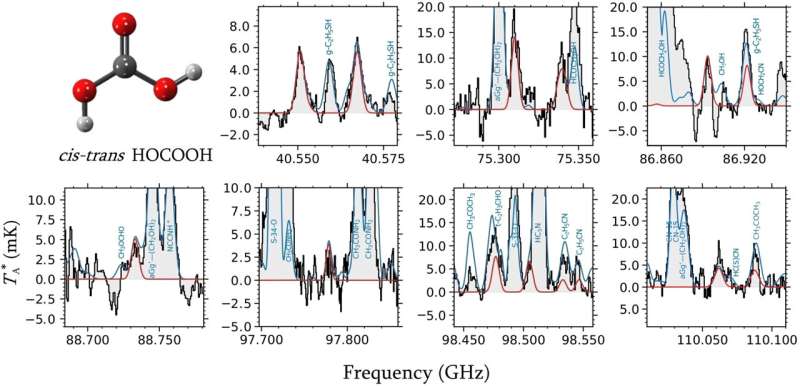August 23, 2023 report
This article has been reviewed according to Science X's editorial process and policies. Editors have highlighted the following attributes while ensuring the content's credibility:
fact-checked
peer-reviewed publication
trusted source
proofread
Evidence of carbonic acid found in interstellar space for the first time

An international team of astrophysicists, astronomers and chemists has found evidence of carbonic acid (HOCOOH) in interstellar space, marking the first time it has been detected in such a setting. In their paper published in The Astrophysical Journal, the group describes their discovery, where it was found, and what it might mean for research into the origins of life.
Prior research has led to the discovery of acetic and formic acid in interstellar space; both are carboxylic acids, as is carbonic acid. All three are believed to be building blocks of life. Finding them in such distant places gives credence to theories that suggest that they were delivered to Earth via comets or meteorites. In this new effort, the researchers were studying the molecular cloud G+0.693-0.027 near the center of the Milky Way when they found evidence of HOCOOH.
Carboxylic acids have a carbon atom and are doubly bonded to an oxygen atom. They are also singly bonded to a hydroxyl group. Carbonic acid is formed here on Earth when CO2 mixes and dissolves in water. It produces the acidic effect in soft drinks. It is also responsible for the increasing acidity of the oceans due to increased amounts of atmospheric CO2.
The research team notes that carbonic acid has been observed on several of Jupiter's moons, on comets and on Mercury and Mars—but this is the first time it has been detected in interstellar space. They also note that the presence of carbonic acid in an interstellar molecular cloud suggests a high degree of complexity in the interstellar medium, which means it may also harbor amino-acid-related compounds. That, they suggest, indicates that continuing to look for other acids, such as glycolic, cyanoacetic, propanoic, or glycine, is a worthwhile pursuit.
They also found an upper limit to the abundance of HOCOOH with respect to diatomic hydrogen in the molecular cloud, which they suggest hints at the possibility that carbonic acid may be abundant in interstellar space. They note that one of the reasons carbonic acid has not been spotted in interstellar space until now, despite its apparent abundance, is that it is undetectable by radio astronomical observations.
More information: Miguel Sanz-Novo et al, Discovery of the Elusive Carbonic Acid (HOCOOH) in Space, The Astrophysical Journal (2023). DOI: 10.3847/1538-4357/ace523
Journal information: Astrophysical Journal
© 2023 Science X Network





















